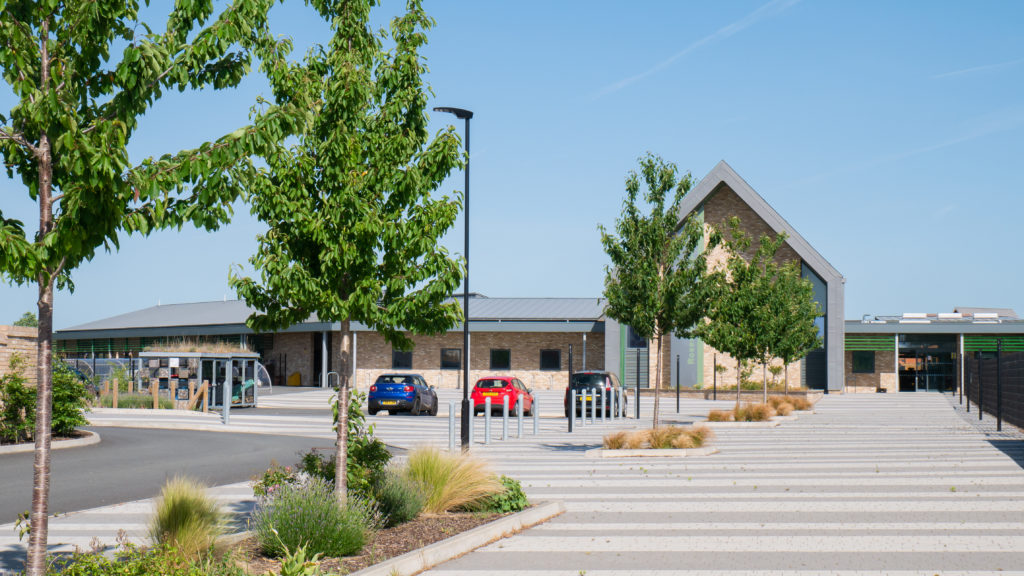The School Rebuilding Programme in 2021 was a government initiative pledging £1bn to rebuild schools. Over 500 schools will benefit from a rebuild or refresh to improve classroom capacities with additional guidance from local authorities to support in and out of the classroom.
The mission for education: for 90% of pupils to achieve the expected standard in reading, writing and maths at the end of Key Stage 2 by 2030.
GreenBlue Urban was proud to support the design and implementation of green infrastructure in our schools and higher education facilities. Advocating a collaborative approach with a focus on constructing cost-effective projects that improve efficiency, help cut carbon emissions, incorporate SuDS, and deliver on time with minimal disruption.

With a new government in force, many were keen to see what pledges were being made about education and how they would be implemented. Other than a full curriculum review, ending VAT for private schools and, of course, the necessary nursery places and additional teachers. What caught our eye was the focus on Mental Health support. With a pledge to provide “access to a specialist mental health professional in every school” so that all pupils can get “early support” before difficulties escalate.
With ongoing pressure to act fast, GreenBlue would like to stress the importance of Green Infrastructure. The benefits are widely publicised; however, in our learning environment, it is imperative. Green infrastructure can improve concentration levels by supplying a more natural and calming outlook and reducing noise pollution, thus positively impacting students’ mental health and well-being.
Only 10% of children in the UK have access to outdoor learning, yet active play is the primary way children learn.
Green, Blue Infrastructure is most effective when combined with other measures. When planning, consider where pupils spend most of their time, including air quality and flooding issues, active travel, outdoor teaching, cooling buildings, and public awareness. In addition to increasing biodiversity, green infrastructure reduces air pollution, with trees being the most effective vegetation type, encourages active travel, engages local communities, and provides outdoor teaching resources. Encouraging positive behaviour, including initiatives such as walking to school and forest schools.
Integrations include:-
- Tree Planting
- Hedges and screens
- Raingardens
- Outdoor Classrooms
- Vegetable Gardens
- SuDS Planters & Water Features
Our collaborative method in dealing with architects, engineers, planners, landscape designers, and contractors enables an innovative and values-led approach. Education remains a strong sector, with hundreds of projects in the last 30 years and successful case studies generated by long-standing expertise and critical areas of attention.
- Advise – early engagement with all to deliver value by assessing funding solutions.
- Analysis – of the site and any perceived constraints
- Guarantee – benefits for all users, amenity, biodiversity, ROI etc
- Recommend – maintenance programmes based on tree species

In today’s world of Carbon Net Zero, reducing emissions and cooling buildings will reduce the use of air conditioning and overall footprint. Green Infrastructure is not just limited to tree planting; when space is limited, consider green walls, green and blue roofs, planters, and SuDS features, including rain gardens.
Successful case studies include the All Saints Primary School in Newmarket a highly commended collaboration between the Water board, (Anglian), and the Local Authority (West Suffolk Council), to reduce stormwater runoff. A SuDS-led multifunctional intervention is a Fun approach!
13 beautiful, thriving trees are enjoyed by all at the Armstrong Building, Newcastle University, thanks to Ashlea Landscapes, which installed StrataCell ArborSystem Tree pits. The results speak wonders and have numerous benefits.
Further collaboration with Anglian and Leicestershire County Council focused on Kibworth Mead Academy. It embarked on a two-phase project to mitigate surface water runoff and protect the school from future incidents in response to recurring flooding. The first phase involved the installation of 10 SuDSPods, designed to remove 50% of the roof water from the school and divert it away from the public sewer system. These pods offered a unique approach to water attenuation, maximising storage capacity while integrating aesthetically into the school environment.

With many more projects, it is no wonder designers and installers are choosing best practice methods for long-term urban greening to guarantee health, activity, and outdoor well-being for now and future generations!
GreenBlue is proud to create healthier urban places in harmony with nature!




